mobile View, to the German Version tap the flag


- Autonomous Region of Spain
- former Castilan Kingdom of Murcia
- since 1833 Spanish Province of Murcia
• Flag
• Historical and other Flags
• Meaning/Origin of the Flag
• Coat of Arms
• Historical Coats of Arms
• Meaning/Origin of the Coat of Arms
• Map of the autonomous regions of Spain
• Numbers and Facts
• History
• Origin of the Country's Name
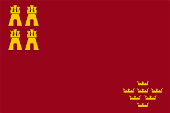
Flag of Murcia,
ratio = 2:3,
Source, by: Flags of the World






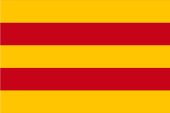
1243–1281,
Flag of the Kingdom of Murcia,
Source, by: Wikipedia (ES)



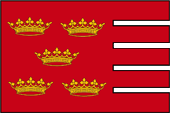
1281-1361,
Flag of the Kingdom of Murcia,
Source, by: Wikipedia (ES)



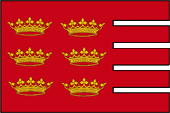
1361,
Flag of the Kingdom of Murcia,
Source, by: Wikipedia (ES)



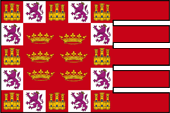
from 1361,
Flag of the Kingdom of Murcia,
Source, by: Wikipedia (ES)



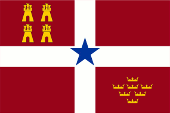
Flag of local nationalists,
ratio – ratio = 2:3,
Source, by: Wikipedia (ES)




The flag of Murcia was officially hoisted for the first time on 5th of May in 1979 and was adopted by law for the Autonomous Community of Murcia with the adoption of the Statute of Autonomy on 9th of June in 1982. Under General Franco's government (1936–1975), all regional flags were banned. After Franco's death (1975), the regional flags were reintroduced or new ones were created. Murcia no longer had its own flag, so the current model was introduced in 1979. The flag is plain crimson red (actually Cartagena red or blood red) and shows four golden castles in the upper corner and seven golden crowns in the flying part. The four castles are taken from the heraldry of Castile and remind us that Murcia was a Castilian kingdom and belonged to the Castilian Crown. The number four stands for the country's four major external borders, towards Aragon, Castile, Andalusia and the Mediterranean. The seven crowns were gradually awarded to the country by kings, starting with five. At the very beginning of the Castilian Kingdom of Murcia, in the 13th/14th century, the country is said to have had a golden flag with two horizontal red stripes. Alfonso X., King of Castile, awarded the city and the kingdom a flag and a banner on 14th of May in 1281, plain red with five golden crowns in it. This was to remember that Murcia was the fifth kingdom to be conquered by the Crown of Castile. The sixth crown was awarded by King Pedro I. on 4th of May in 1361 because the Kingdom of Murcia had remained loyal to Castile during the Peter's Wars. In the same year, a lavish heraldic banner was introduced. The seventh crown was awarded on 16th of September in 1709 by King Philip V. because the Kingdom of Murcia had supported him during the War of the Spanish Succession. This is still reflected today in the coat of arms of the City of Murcia. It is not known that there was a flag with seven crowns for the kingdom. It is likely that the last model of the flag from 1361 fell out of use at some point. The kingdom ended in 1833 and was divided into the provinces of Albacete and Murcia. Albacete is a part of Castile-La Mancha since 1982. The colour red of the today's flag is called Cartagena red, it is best compared to blood red. The choice of color was random and was arbitrarily named Cartagena Red.
Source: Wikipedia (ES),
Flags of the World,
Volker Preuß


since 1982,
Coat of arms of Murcia,
Source, by:
Wikipedia (DE)
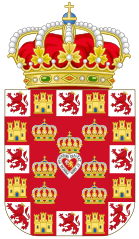
today's coat of arms of the City of Murcia,
Source, by: Heralder, CC BY-SA 4.0, via Wikimedia Commons


1266-1361,
Coat of arms of the Kingdom of Murcia,
Source, by: Wikipedia (ES)

from 1361,
Coat of arms of the Kingdom of Murcia,
Source, by: Wikipedia (ES)

The coat of arms of Murcia was created in 1982 and its design is based on the flag, with the exception of a golden border. On 4th of May in 1983 it was adopted by law for the autonomous community of Murcia. It is plain crimson (actually Cartagena red or blood red) and shows four golden castles in the upper corner and seven golden crowns opposite. The four castles are taken from the heraldry of Castile and remind us that Murcia was a Castilian kingdom and belonged to the Castilian crown. The number four represents the four great external borders of the country, towards Aragon, Castile, Andalusia and the Mediterranean. The seven crowns were granted to the country progressively, but starting with five, by kings. Alfonso X, King of Castile, granted the city and the kingdom a plain red coat of arms with five golden crowns in it on 14 May 1281. A surrounding border changed the symbolism of Castile and Leon. The five crowns were intended as a reminder that Murcia was the fifth kingdom to be conquered by the Crown of Castile. The sixth crown was awarded by King Pedro I on 04.05.1361 because the Kingdom of Murcia had been loyal to Castile during the St Peter's Wars. The seventh crown was awarded by King Philip V on 16.09.1709 because the Kingdom of Murcia had supported him during the War of the Spanish Succession. This is still reflected today in the coat of arms of the city of Murcia. The red in the coat of arms is called Cartagena red, it is best compared to blood red. The choice of colour was random and arbitrarily named Cartagena Red.
Source: Wikipedia (ES),
Flags of the World,
Volker Preuß

The autonomous Regions of Spain:
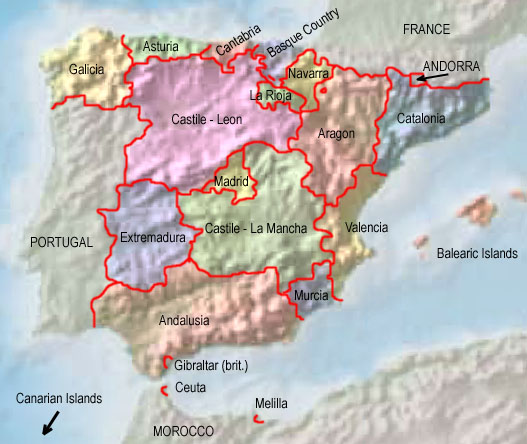
Source: Freeware, University of Texas Libraries, modyfied by: Volker Preuß

Area: 4.368 square miles
Inhabitants: 1.531.878 (2022), mostly New Castilians
Density of Population: 351 inh./sq.mi.
Capital: Murcia, 462.979 inh. (2022)
Seat of Parliament: Cartagena, 216.961 inh. (2022)
official Language: Spanish (Castilian)
other Languages: Murcian (Panocho), Catalan
Currency: Spanish (Euro) currency
Time Zone: GMT + 1 h
Source: Wikipedia (DE)

early age · settlement of Iberians
ca. 600 B.C. · immigration of Celts, mix with the Iberians, evolution of the Celtiberians
228 B.C. · the Carthagian General Hasdrubal (brother of Hannibal) erects on the coast of Iberia – which belongs to the Empire of Carthago – the City of Carthago Nova (the today’s Cartagena)
218–201 B.C. · Second Punic War, the Roman Empire acquires the possessions of Carthago in Iberia, subjugation of whole Iberia until the year 19 B.C., Roman settlement, romanization, the today’s Murcia comes fifty-fifty to the Roman provinces of Baetica and Hispania Taraconensis
415–418 A.D. · arrival of the Western Goth in context of the Great Transmigration (Migration Period), the today’s Murcia becomes a part of the Empire of the Western Goth
425 · the Teutonic Vandals conquer and destroy Carthago Nova
6th century · the Iberian south coast comes to the East Roman Empire (Byzantium)
711–714 · annihilation of the Empire of the Western Goth by from northern Africa coming Arabs, the Western Goth retreat to Asturia and Cantabria, the south of the today's Murcia becomes occupied by the Arabs, establishment of the Arabian Emirate of Cordoba, arabization, islamization
825 · re-foundation of the City of Murcija on the ruins of the Roman town Murcia
929 · the Emirate of Cordoba becomes transformed ot the Arabian Califate of Cordoba under the dynasty of the Omajjads
1010 · overthrow of the Omajjads dynasty, to 1040 disintegrates the empire in some arabian kingdoms (E.G.: Malaga, Algeciras, Granada, Cordoba, Toldeo, Valencia, Zaragoza, Denia, Murcia and Badajoz)
1063 · Abd Er Rahman ibn Tahir declares his independence from Valencia and establishes the Kingdom of Murcia (until 1243)
1243 · Murcia Town becomes liberated from the Arabs by Alfons X. of Castile and his troops, establishment of the Castilian Kingdom of Murcia
1829 · Murcia Town becomes fully destroyed by an heavy earthquake
1833 · the partial kingdoms and regions that had existed in Spain until that point in time became divided into provinces, the Kingdom of Murcia is divided into the provinces of Albacete and Murcia, since 1982 Albacete belongs to Castile-La Mancha
9th of June in 1982 · Murcia gets the statute of autonomy within Spain, establishment of the "Autonomous Community of Murcia"
Source: Wikipedia (EN),
World Statesmen,
RetroBib Retrobibliothek,
Volker Preuß

The name "Murcia" goes back to an additional name of the Roman goddess Venus, which was given to her during cult activities. The Romans used this name for a former Carthaginian settlement that they took possession of after the Second Punic War. The Arabs left the name unchanged.
Source: Handbuch der geographischen Namen


![]()
























